André Klein's Blog, page 18
January 28, 2014
False Friends: 5 German Words That Don’t Mean What You Think They Do
German and English are both Germanic languages, so they not only share many grammatical features but also have a lot of similar words. For example, when you know English and you hear the German word “Haus” you immediately know what it means: house. The spelling is different, but it sounds exactly the same!
Similarly, a “Freund” is a friend, “Sand” is sand, “grün” is green, and so on and so forth. And as it happens when two languages are very close, there are also many words which seem the same but mean completely different things.
Gherkins in Your Face
When you walk into a store in Germany and ask for a glass of “Pickel (m)”, don’t be surprised if you get strange looks. You just asked for a glass of pimples. Yummy!
The words sound exactly the same, even the spelling is nearly identical. However, the correct German translation of the English word “pickle” is “Gewürzgurke (f)” or “saure Gurke (f)”.
So, the next time you see an ad for “Anti-Pickel” creams, rest assured. People aren’t supposed to apply it to their food, but to their face!
Higher Up The Food Chain
You’re in a restaurant. The food is either incredibly good or unbelievably bad. At any rate, its quality diverges enough from the blandness of average that you’d like to have a word with the “chef”. The waiter complies with your request, and minutes later a man walks up to your table. But before you can ask why he isn’t wearing his white hat and apron, you realize that this man isn’t working in the kitchen. He owns the place! He’s the chief, head of staff, manager, leader, call him whatever you like, but he’s higher up the foodchain than your average mess sergeant.
Put simply, the German word “Chef (m)” simply means: boss. The person who does his magic in a kitchen is called “Koch (m)”.
NOTE: There is also the German word “Chefkoch (m)” which means “head chef”. But the idea is the same: the German “Chef” refers to a position in a hierachy, not an occupation.
Where Your Clothes Come From
Another confusing German word is “Fabrik (f)”. English speakers stumble over a word like “Baumwollfabrik (f)”, and — assuming they know that “Baumwolle (f)” means cotton — the conclusion is simple: it must be cotton fabric!
However, the German word “Fabrik (f)” means something totally different, namely: factory. Thus, a “Autofabrik” would be a car factory, a “Wurstfabrik” a sausage factory, a “Baumwollfabrik” a cotton factory, and so on.
In short, a “Fabrik (f)” is a place where things are fabricated. If you want to talk about textiles in German, the correct word is “Stoff (m)” or “Gewebe (n)”. So, in our example above, cotton fabric would simply be “Baumwollstoff” or “Baumwollgewebe”.
Pump Up The Volume
Imagine, a friend invites you over and offers to show you the new “Box (f)” he bought. A box of what? While you’re still wondering where it is and what’s in the box, he pushes a button on a remote and your question gets knocked from your lips by the subwoofer.
It’s one of these German words like “Handy (n)”, which refers to a mobile phone. It seems like it’s an English word — and it certainly once was — but the German language gobbled it up and changed it beyond recognition.
Thus, in German, a “Box (f)” is nothing more than a loudspeaker. (Since they come in pairs, you’ll often hear the plural “Boxen”). It’s a shorthand for “Lautsprecherbox”, the first part “Lautsprecher (m)” being a direct equivalent to the English “loudspeaker”.
Floozies In The Air
Once upon a time there used to be a rapper called “Puff Daddy”. Allegedly he took on the moniker because he used to “huff and puff” and get angry, so friends called him Puffy.
In Germany however, the name “Puff Daddy” always had a slightly different ring to it, because there’s a word in German which is spelled exactly the same way: “Puff (m)”. The pronunciation is a bit different, in that the vowel of the German word sounds like the “oo” in “foot”, but that’s not the only thing which is different about it.
In short, a “Puff (m)” in German is a brothel, cathouse, bordello, a den of iniquity — however you please — not a “short, explosive burst of breath or wind” (although these gasps may indeed be commonplace in aforementioned establishments).
Therefore, caution should be exercised when talking about “puffing a cigarette” or a “puff of wind. There is no one-size-fits-all translation. The German verb “paffen” refers to the activity of indulging in tobacco products, while the noun “Zug (m)” (from “ziehen” – to pull) would refer to a “puff” from the former. Hence, a “puff of air” would be a “Luftzug (m)”, but “huff and puff” is best translated as “schnaufen und keuchen”.
–
These are just a few of false friend for English German learners. Which ones did you come across in your own studies? Tell us in the comments!

 About the author:
André Klein was born in Germany, has grown up and lived in many different places including Thailand, Sweden and Israel. He has produced two music albums, performed and organized literary readings, curated an experimental television program and is the author of various short stories and non-fiction works.
About the author:
André Klein was born in Germany, has grown up and lived in many different places including Thailand, Sweden and Israel. He has produced two music albums, performed and organized literary readings, curated an experimental television program and is the author of various short stories and non-fiction works.
The post False Friends: 5 German Words That Don’t Mean What You Think They Do appeared first on Learn Out Live!.





January 22, 2014
Streamline Your Podcasting Workflow With Auphonic Audio Post Processing

Podcasting can be a great way to get in touch with your audience in a different way. Whether you’re an independent teacher offering weekly study tips or an indie publisher sharing tools and strategies, podcasts make it easier to communicate your message in a direct and very personal manner.
There are many different programs and platforms out there to get a podcast off the ground. But no matter what tool you use, in the end a podcast is nothing more than an RSS-feed with audio attachments. In short, a list of mp3s which users can subscribe to, so they’ll always get the latest episode.
If we put aside all the initial setup of configuring a feed, adding artwork, making it iTunes friendly, etc. at the heart of any podcast are audio files. The quality of these files, and the ease with which you can publish more for your subscribers, is what makes or breaks a good podcast.
Automate your Audio Production Process
Imagine there was a simple tool with which you could automatically clean your recorded audio files from noise and rumbles, normalize volume between different voices, add an intro and outro and send the finished file to Soundcloud or your own server.
Enter Auphonic, the free “post production web service for broadcaster, podcasts, radio shows, audio books, lecture recordings, screencasts and more.”
Auphonic can literally save you hours of meticulous manual audio editing, metadata configuration and distribution to different places across the web.
How To Use Auphonic
After having registered for free at auphonic.com you’ll see a big red button that says “New Production”. Click it and you’ll be transported to the main form.
You can upload your audio (or even video file) either from your computer or from one of your external services, such as SoundCloud, Dropbox, blubrry, libsyn, FTP, YouTube and more. In order to use these services you need to first register them by going to auphonic.com/engine/services. Note: These services can act both as sources and as destination for your files.
In the next step you can add an intro or outro to your audio file which is super convenient for podcasting purposes. Basically, you just select a source for your intro or outro file and Auphonic will automatically stitch these files to the beginning and end of your recording.
The next screen covers Metadata (both basic and extended). In case you’re wondering what you need it for – Metadata is what makes your mp3 player show an image during playback (such as an album cover or podcast artwork) and other information.
In the next step, you can tell Auphonic in what format and bitrate you’d like to have your finished audio file, and what to call it (output filename).
After that you can select to which destinations you want to deploy your finished production. In the example below, I’ve selected FTP, SoundCloud and Youtube. And yes, once you start the production Auphonic will upload your production to all selected services simultaneously and automatically.
Last but not least, you can tell Auphonic how to optimize your recording. Not only are there are a number of different audio algorithms to choose from, they are also all very excellent and sometimes much better than standard desktop audio editing software. If you’re not sure what each of these do, take a look at the Auphonic Audio Examples.
Once all is set, click on “Start Production”. First the file will be uploaded. In the next step, Auphonic’s algorithms will do their magic and then you’ll see the results page:
Set & Forget Post-Processing
Of course, you don’t need to do all of the above every time you upload a new file or episode. Instead you can simply create a Preset so that Auphonic will automatically fill in the information.
If you haven’t yet setup your own podcast or aren’t happy with existing platforms, there’s a great free Podcasting plugin for WordPress called Podlove Podcast Publisher which integrates beautifully with Auphonic and makes publishing new episodes to your feed so much easier and more fun.
-
photo: Creative Commons by brainblogger

 About the author:
André Klein was born in Germany, has grown up and lived in many different places including Thailand, Sweden and Israel. He has produced two music albums, performed and organized literary readings, curated an experimental television program and is the author of various short stories and non-fiction works.
About the author:
André Klein was born in Germany, has grown up and lived in many different places including Thailand, Sweden and Israel. He has produced two music albums, performed and organized literary readings, curated an experimental television program and is the author of various short stories and non-fiction works.
The post Streamline Your Podcasting Workflow With Auphonic Audio Post Processing appeared first on Learn Out Live!.





January 14, 2014
Top 10 German Movies For Learners

Learning German with stories is an effective and fun way to practice and enjoy yourself at the same time. I’ve already written about a selection of German short stories. Today, I’d like to present a number of my top 10 favorite German movies for learners (in no particular order). Where available, I’ve added vocabulary and exercise resources to help you make the most out of using these movies in your German studies.
Das Leben Der Anderen “The Lives of Others” (2006)
 8.5/10
8.5/10
Set in 1984 East Berlin, an agent of the secret East-German police (Stasi, short for Staatssicherheit) conducts a surveillance operation on two young artists, becoming preoccupied with the couple’s personal life. This award-winning drama movie is rich with engaging dialogue, convincing characters and a tense plot.
Since the dialogues are sometimes long and key to understanding, turning on subtitles might prove to be essential for most learners.
Das Experiment “The Experiment” (2001)
 7.8/10
7.8/10
Based on the 1971 “Stanford Prison Experiment”, this is a story of a team of researchers re-creating prison conditions in a laboratory. Twenty men are asked to play the roles of prisoners and guards over a period of two weeks. But it’s only so long before the participants become overly engrossed in their play, and the boundaries between reality and role-play slowly come apart.
Albeit the film’s somewhat dark theme, its plot is rather easy to follow due to the very clearly defined roles and setting.
Die fetten Jahre sind vorbei “The Edukators” (2004)
 7.5/10
7.5/10
A group of young Berlin activists are breaking into rich people’s homes, rearranging furniture and leaving obscure notes to make them feel insecure. When one of the affluent home-owners returns unexpectedly, the activists find themselves hatching out a make-shift kidnapping plot.
Since the protagonists are all in their late 20s this movie is a good way to get into colloquial speech.
Goodbye Lenin (2003)
 7.7/10
7.7/10
It’s 1990. The Wall has fallen. The protagonist’s mother has just awoken from a coma, unaware that her beloved German Democratic Republic is not existing anymore, and he soon finds himself creating an elaborate fantasy to convince her that everything is still as it used to be.
This film is not only a great way to learn about Germany’s split and reunification from a personal perspective, it also features some sections where the protagonist narrates the action on screen, which is helpful for following the plot.
Lola rennt “Run Lola Run” (1998)
 7.8/10
7.8/10
 Goethe-Institut Arbeitsmaterialien [PDF]
Goethe-Institut Arbeitsmaterialien [PDF]
 Exercises by University of Michigan [DOC]
Exercises by University of Michigan [DOC]
A young German woman has exactly 20 minutes to raise 100,000 Deutschmarks to protect her boyfriend who has fallen in with the wrong people. This fast-paced (and often strange) movie is set against the background of Berlin and re-tells the same story in different ways.
This movie can be a good starting point for discussions in a learning group due to its alternative narratives.
Knocking on Heaven’s Door (1997)
 8.0/10
8.0/10
Two patients in a hospital discover they are terminally ill. Sharing a tequila bottle, they realize that one of them has never seen the ocean. So they escape from the hospital and steal a car, driving it towards the German North Sea coast, unaware that the car’s trunk holds one million in cash whose owners are not to be trifled with.
While the actors are sometimes mumbling a bit, the plot is easy to follow and dialogues are full of common patterns of speech.
Baader Meinhof Komplex (2008)
 7.4/10
7.4/10
Starring many popular German actors, this movie, set in West Germany during the 60s and 70s, tells the story of the radical-left militant group Rote Arme Fraktion, illuminating their protagonists’ motivations, denials and complications. It’s both political thriller, psychological drama, and certainly worth a watch to better understand this sad and difficult chapter of German history.
Der Himmel über Berlin “Wings of Desire” (1987)
 8.1/10
8.1/10
This is the original film Nicolas Cage’s “City of Angels” was based upon. The story is the same: an angel falls in love with a human woman, but in order to love her fully, he has to descend from his angelic status. Director Wim Wenders does a beautiful job of creating context and poetic atmosphere.
The relaxed pace of the movie and use of voice-over internal monologues makes this classic approachable for learners.
Auf der anderen Seite “The Edge of Heaven” (2007)
 7.9/10
7.9/10
When widower Ali convinces the prostitute Yeter to move in with him, his Son Nejat is irritated. Onlly when Nejat finds out that Yeter regularly sends money to her daughter Ayten, he begins to show compassion. After Yeter’s sudden death, Nejat decides to fly to Turkey to look for Ayten, whose trace leads back to Germany.
The narrative style of this movie is very visual which allows to follow the storytelling even if you don’t understand each word.
Hitlerjunge Salomon “Europa Europa” (1990)
 7.7./10
7.7./10
 Quizlet Vocabulary [2] [3]
Quizlet Vocabulary [2] [3]
In the early days of WWII, a Jewish boy is separated from his family, poses as a German orphan, is accepted into Nazi society where he’s celebrated as a “war hero” and eventually made a Hitler Youth. This movie, based on a true story, has a bitter-sweet touch of both drama and comedy, which ultimately culminates in a very unusual perspective.
-
image: Some rights reserved (CC) by Express Monorail via flickr

 About the author:
André Klein was born in Germany, has grown up and lived in many different places including Thailand, Sweden and Israel. He has produced two music albums, performed and organized literary readings, curated an experimental television program and is the author of various short stories and non-fiction works.
About the author:
André Klein was born in Germany, has grown up and lived in many different places including Thailand, Sweden and Israel. He has produced two music albums, performed and organized literary readings, curated an experimental television program and is the author of various short stories and non-fiction works.
The post Top 10 German Movies For Learners appeared first on Learn Out Live!.





January 9, 2014
3 Free Search Ranking Trackers

What’s the most often neglected factor that can bring small businesses and freelancers the biggest impact in terms of online marketing for the smallest budget? It’s not Social Media, Google Adwords or any other paid advertising scheme. No, it’s SEO (search engine optimization).
Whenever I mention these three letters to colleagues and friends, I get that look, hovering halfway between ridicule and information overload. SEO? In the best case scenario people deem it insanely complicated and technical, in the worst case they just write it off as a scam. But what is search engine optimization really? There’s a lot which can be said about it — and yes, there are many moving parts — but the idea is so simple any child can understand it.
SEO means making sure that people find your site when they’re typing in certain words into a search engine
Let’s say you make the best cheese cake in Chicago. Doing good SEO means that when someone on the planet looks for “cheese cake Chicago” they’ll find your store, not on page four, five or three-thousand, but on page one, position one (or ranking as high as possible).
Reaching that sweet spot has become sort of a holy grail. People pay tons of money to “experts” whose expertise is often difficult to assess, or they fall for scammers and their too-good-to-be-true shortcuts.
First of all, it’s a good idea to manage one’s expectation. There’s no easy way to get from page 3000 to the first page in one day. But, there are all kinds of optimizations a person can do without a lot of technical expertise that have long term effects.
In the end, nobody (!) really knows how search engines rank stuff (except their engineers), and on top of that they keep changing their algorithms. There are no magic pills or silver bullets here. However, there’s a very simple principle:
By making small changes and analyzing your search results over a period of time, you see what works
In short, forget about all the technical details for a moment. SEO is about learning by doing. If today you’re on page 40, you make a few small SEO optimizations, and in a few months you’re slowly rising, you’re probably doing something right! If you’re falling or nothing happens, then maybe you should try something else instead.
Search Ranking Tracking For Beginners
In order to make this “learning by doing” approach to SEO work, the most important element (besides learning about common SEO practices) is to regularly check your search ranking.
You could of course go to Google every morning, type in “cheese cake Chicago” and see if the results are changing, but there are a few problems with that:
It takes a lot of time
Your search results are filtered, i.e. they are different from what customers might see
In order to prevent the filtering you can open your browser in Incognito or Private mode, and go to google.com/ncr (no country redirect) in order to get vanilla results which aren’t affected by your local settings and preferences.
But still, it’s no fun to do this manually. There are a number of tools out there, that can check multiple keyword combinations for you, automatically, across different search engines and locales. Many of these so called search ranking trackers can be pricey for beginners, so today I’d like to present three different search ranking trackers which are completely free.
1. SeoBook.com’s Rank Tracker Firefox Plugin

This little add-on runs in the background of your Firefox browser. Its functions are simple but straightforward. You can enter the domain you want to track, a number of keywords and which search engines to analyze. After a little while (depending on the amount of keywords) you’ll get a nice list of results showing you exactly how well you rank for each keyword
Keyword lists can be saved, exported, etc. Note: In order to download this add-on you need to register a free account on seobook.com.
2. Cute Rank Search Ranking Tracker

The CuteRank search ranking tracker is a standalone tool for Windows and Mac. There’s both a free and a premium version available. The free version only allows tracking of one domain, but for many people this will be enough to get their feet wet.
This search ranking tracker works similarly to the one above. You enter your domain, which keywords you want to track on which search engines, and CuteRank will compile nice-looking tables and even graphs.
3. Rank Checker Ace
Last but not least, here’s my favorite free search ranking tracker: Rank Checker Ace. It doesn’t look like much at first, but its features are impressive for a free tracker, allowing you to track 1000 keywords in total and 100 per domain.
Contrary to the above tools, Rank Checker Ace is not dependent on your local machine. Firstly, it runs in your browser, like professional premium search ranking trackers, meaning you can access your data from anywhere. Secondly, Rank Checker Ace runs the search queries through their own system so that you don’t have put up with proxies in order to circumvent Google’s limitations and captchas.
Another cool feature is that you can schedule daily or weekly emails with your results, so that while sipping your coffee in the morning you can get a quick overview what’s happening to your URLs and keyword rankings.
Last but not least, Rank Checker Ace also gives an estimate of local and global search per keyword – something that none of the above trackers do – so you can get an idea of the potential traffic for each search term.
Rank Checker Ace may look a bit complicated in the beginning, but don’t be dismayed. Behind the plain surface hides a lot of power. Also, they have a fairly comprehensive help section to get you started.
Which search ranking tracker are you using? Why? Tell us about it!
-
photo: CreativeCommons by stephenjohnbryde

 About the author:
André Klein was born in Germany, has grown up and lived in many different places including Thailand, Sweden and Israel. He has produced two music albums, performed and organized literary readings, curated an experimental television program and is the author of various short stories and non-fiction works.
About the author:
André Klein was born in Germany, has grown up and lived in many different places including Thailand, Sweden and Israel. He has produced two music albums, performed and organized literary readings, curated an experimental television program and is the author of various short stories and non-fiction works.
The post 3 Free Search Ranking Trackers appeared first on Learn Out Live!.





December 15, 2013
Ten-Year-Old Girl Publishes on Amazon
A mother’s story.
 I’m honoured to have been invited by André Klein to share my daughter’s book publishing story on LearnOutLive. It’s a story about joy in learning, love of books, and a little girl’s passionate business idea.
I’m honoured to have been invited by André Klein to share my daughter’s book publishing story on LearnOutLive. It’s a story about joy in learning, love of books, and a little girl’s passionate business idea.
It all started one day when she came home really excited because she’d written a story in school. When she showed me the story, all I could say was ‘this is just the first chapter …”. She looked at me oddly in a goose-pimply way and answered ‘That’s exactly what my teacher said’. Then she said ‘I have something to do’ and ran off into her bedroom, only to reappear a couple of hours later, with a secretive look on her face.
A few days later, Elisabeth and her little brothers and sisters ( seven year old twins and six year old baby sister) held a secret meeting on the beach and announced that they were setting up a secret business. We weren’t allowed into Elisabeth’s bedroom during their ‘business hours’, which turned out to be about two hours a day every day from September to Christmas 2012 – just before 2013 chimed in last year. On Christmas Day, the four children then presented us with their books. It was a magic moment and we were so proud of all of them. It wasn’t just that they’d wanted to write books or have a secret business, it was the way they had worked together for months according to a schedule and hadn’t given up on their dream.
My eldest daughter Elisabeth and the twins published their books in Greek paperback version in January 2013. My youngest had created an alphabet book and it won’t be long till her skills are up to publishing too.

Elisabeth’s school held a book signing day for her where parents came in and some classmates bought books. She was also invited to a book writer’s exhibition where she presented her book and read her story to a packed audience. The event was covered in the local papers too. Since then Elisabeth’s teacher Eleni Papayiorgiou has done great work encouraging other children in the school to start reading and writing. Another boy, Dimitris Dadalis who is 11 years old, won a writing competition and published his own book, meetings were held to encourage parents to buy and share more books for their kids, and another book exhibition is planned for the upcoming Christmas celebrations.

Not to be outdone, my son Poseidonas decided to take some of his own limelight and went up to the stage area without being asked, grabbed the mike, and started reading out his story too. Many people were surprised because they were still trying to grasp the fact that a ten year old had written a book, and didn’t know where this little man had sprung out from. His twin sister, Thalassini, was too shy to read hers out.

My kids have written more books since then, and Poseidonas is waiting for me to publish his new comic book series in digital format. Later there was book signing and speaking to the local kids who had hundreds of questions to ask.

The Magic Roots is the English translation of Elisabeth’s book and is in ebook format for the first time. It’s a fantasy story about magical creatures who are on a mission to reveal the ultimate secret of the forest through adventurous quests and challenges. It’s a children’s book written by a child for children. It captures the essence of certain things that adults can only grasp at, because a child sees and feels things differently. Yet, it’s wise enough to please an adult reader too.
Amazon US | UK | DE | FR | ES | IT
As André Klein describes in his review:
“I wish there were more stories like these: written for children, by children. The original illustrations are beautiful, especially on full color screens. Regarding the story itself, I can only say: read it and delve into an enchanted forest filled with quirky creatures and an inquisitive band of intrepid young travelers.”
As an Edupreneur who teaches, blogs, writes, and organizes professional development online with international colleagues, I’ve been wanting to do my own publishing for quite some time. André Klein at LearnOut Live has given me invaluable advice from the start and everything I learnt about publishing came from LearnOutLive. My kids and André have definitely been giving me a push in the right direction, and my kids say to me – “If we can do it, so can you.”
How did it all REALLY begin?
It seems to me that having a number of siblings growing up in the same house who are close together in age is a magic ingredient for learning. If the first child learns to love reading and shares this with siblings, that’s when the magic happens. My two magical tools for child-raising are books and art. As well as writing and reading a lot, they are developing strong artistic skills. I experienced large family inspiration when I was a child growing up with seven siblings, and have warm memories of all of us around the table, drawing and playing lego.
As large families are unfeasible for most people these days, I strongly advise parents and schools to get together for community project work. Play dates for reading, art and drama could emulate the sibling effect. If teachers advised parents about creative home learning activities we could bridge the gap between home/school and motivation.
Here are some tips based on my experience and on many parenting and educational psychology books that I’ve read.
1) Read to your baby from day one. New born babies respond to your voice, tone, and vibes. It’s never too early to begin. If you have older kids and want them to read more, try using comics or digital story-boarding tools if they refuse to read books. This could be a great topic for another article as I have very definite ideas for reluctant readers.

Elisabeth at eight months old
2) Build your baby book library.
As soon he/she they can hold something buy some baby books full of pictures for your child.
3) What if they eat the books?

You may experience problems when they get to the book-eating stage – when everything they see is something to be eaten – the cookie monster effect. My twins literally guzzled their way through Elisabeth’s books indiscriminately. What we did then was hide the books before they were all destroyed and we started oral story-telling activities. This was probably the most important part of their development with regard to creativity. We told each other so many stories in so many different ways.
4) Lead by example.
Of course, in my household it was easy for the children to be influenced as I’m a book worm myself, with a taste for all that’s quirky and creative. In some homes religion or football serve to represent revered ideals for a child’s upbringing. In my home, books and learning replace religion and football. Of course upholding morals and playing sports are also important things that we do, but nothing can be fully appreciated in life without a critical mind, confidence, imagination and the art of self-expression.
5) Have fun.
Once children discover that learning is fun, then they become self-organised learners. I wrote about this in a recent article when I examined ideas expressed by David Deubelbeiss and Sugata Mitra. These, days my kids are racing ahead of me and I’m struggling to keep up. When they were toddlers I was racing to keep them out of mischief. Little did I know how happy I’d be to be still racing after their thousands of drawings, stories and self-organised antics to this day.
Remember!!
Show them the fun and they’ll do the rest.

You’ve been reading a guest post by Sylvia Guinan

Sylvia Guinan has a degree in English literature and has been teaching for fifteen years. She began teaching online in 2010 and is particularly interested in brain-friendly learning methods,tools, environments and communities.
Website & Blog: sylviasenglishonline.org
Twitter:
ESLbrain

 About the author:
Sylvia Guinan has a degree in English literature and has been teaching for fifteen years. She began teaching online in 2010 and is particularly interested in brain-friendly learning methods,tools, environments and communities.
About the author:
Sylvia Guinan has a degree in English literature and has been teaching for fifteen years. She began teaching online in 2010 and is particularly interested in brain-friendly learning methods,tools, environments and communities.
The post Ten-Year-Old Girl Publishes on Amazon appeared first on Learn Out Live!.





December 9, 2013
German Gamebooks For German Learners

Gamebooks (“Spielbücher” in German), or “choose your own adventure” books, as they’re often called, were all the rage in the 70s and 80s. The idea was simple: to create a book where the reader can influence the story by making choices along predefined paths.
In some ways, gamebooks can be considered the predecessor of point-and-click adventure games. And now, in the age of ubiquitous computing, they’re making a comeback on our desktops, ereaders, tablets and smartphones, aided by crowd-founding platforms like Kickstarter.
A gamebook is a work of fiction that allows the reader to participate in the story by making effective choices. The narrative branches along various paths through the use of numbered paragraphs or pages. – Wiki
There is much to be said about the history of gamebooks. Interestingly, the idea of branching narratives first appeared in the 1941 story ”The Garden of Forking Paths” by Jorge Luis Borges, in which a fictional author creates a story with nine possible endings.
It was only in the late 50s, however, that the concept of gamebooks was applied to actual texts. And while we mostly associate gamebooks today with fiction genres such as fantasy, sci-fi or mystery, the first gamebooks were actually educational in nature.
Using Gamebooks For Language Learning
Pioneered by American behavioral psychologist B. F. Skinner, the idea to use gamebooks in education was an appplication of “programmed learning”, a method of self-study using machines or interactive books:
Students choose from multiple-choice answers and then are prompted to proceed to another page of the book depending on their answer. If a correct answer is given, students move on to another page with more information to learn and more questions to answer. An incorrect answer leads to comments on why the answer is incorrect and a direction to return to the original question to make another selection. – Psychology Encyclopedia
In a sense, the educational gamebook is the grandfather of self-study apps such as Rosetta Stone, Duolingo and other interactive forms of computer-supported language-learning.
By using gamebooks in language learning, we can get both the benefits of interactivity and the immersion of delving into a foreign language narrative, identifying with characters, engaging in authentic dialogue, etc.
In short, if done right, gamebooks combine the fun of video games and storytelling to boost reading, vocabulary and grammar competencies. There aren’t yet many gamebooks out there specifically designed for language learners, but since gamebooks alternate short text passages with actions, they can be a good entry-point to reading authentic literature.
Where to get GooD German Gamebooks?
The following selection consists of German gamebooks designed for native speakers. To get the most out of reading these books, I recommend using a good dictionary, compiling word lists and flashcards for memorization.
While many of the classic German gamebooks (often translated from English) such as Fighting Fantasy are out of print, the Lonely Wolf (German: Einsamer Wolf) series, for example, is still available to this day on Amazon and other stores.
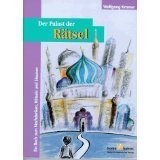 Not all German gamebooks were translations, however. In 1996 German game designer Wolfgang Kramer created a mini-series of two gamebooks which mixes puzzle elements with branching narratives. In the first volume, for example, the protagonist/reader is incarcerated in a palace, and by solving puzzles of various kinds, he ventures deeper into the palace and eventually tries to escape. The second volume takes place in a pyramid, where the goal is also to first discover the secrets of the pyramid through logical puzzles and then to escape at the end. The two books are called:
Not all German gamebooks were translations, however. In 1996 German game designer Wolfgang Kramer created a mini-series of two gamebooks which mixes puzzle elements with branching narratives. In the first volume, for example, the protagonist/reader is incarcerated in a palace, and by solving puzzles of various kinds, he ventures deeper into the palace and eventually tries to escape. The second volume takes place in a pyramid, where the goal is also to first discover the secrets of the pyramid through logical puzzles and then to escape at the end. The two books are called:
Der Palast der Rätsel. Hugendubel, 1997, ISBN 9783880348431
Die Rätsel der Pyramide. Hugendubel, 1995, ISBN 9783880349216
These books seem to be out of print, but I’ve seen both the first and the second book on the German Amazon and Ebay as second hand editions.
Another series of German gamebooks (6 volumes) was created by German fantasy author Markus Heitz, released by Pegasus publishing, and takes place in two of his previously established universes: Die Zwerge and Ulldart.
Die dritte Expedition. Pegasus Press, 2005, ISBN 3-937826-46-7.
Todesbote. Pegasus Press, 2006, ISBN 3-937826-47-5.
Die Sterne der Tiefen. Pegasus Press, 2006, ISBN 3-937826-48-3.
[...]
Many of these books are available through Amazon.com, Amazon.co.uk, and other stores.
Last but not least, another noteworthy German gamebook creator is Jens Schumacher. So far, he has released 12 German gamebooks, split into two separate series: Alpha 2 (sci-fi, 4 volumes) and Die Welt der Abenteuer (fantasy, 8 volumes):
Alpha 2
Irrfahrt im All. Herder, 2006, ISBN 3-451-70680-6.
Angriff der Gmorffs. Herder, 2006, ISBN 3-451-70681-4.
Schiff der Verdammten. Herder, 2006, ISBN 3-451-70682-2.
Der Schatz von Sumura. Herder, 2006,, ISBN 3-451-70683-0.
Die Welt der Abenteuer
Das Vermächtnis des Zauberers. Schneiderbuch, 2009, ISBN 978-3-505-12533-1.
Geisterspuk in der Zwergenmine. Schneiderbuch, 2010, ISBN 978-3-505-12637-6.
Der Schatz der Oger. Schneiderbuch, 2010, ISBN 978-3-505-12766-3.
[...]
Since these books are all relatively new, they can be easily obtained on Amazon.com, Amazon.co.uk and other international stores. Some of these books are also available as Kindle edition, so you can take them along on your smartphone, ereader, tablet, etc.
Free online Gamebooks and gamebooks for german learners
If you’ve never played a (German) gamebook before and just want to have a little taste before you order a full book, I recommend a visit to spielbuch.net where you can play German gamebooks for free, in your browser. Visit this link to get a full listing of playable gamebooks in German. After selecting a book, look for the link that says “online spielen”.
When you play a German gamebook on your Kindle or in your browser, you can easily translate difficult words by using the Kindle dictionary or a browser extension. However, you might find that these books often use archaic words and expressions mixed with fantasy names and locations, and are therefore difficult for beginners or intermediate learners.
To make the fun of language learning through gamebooks more accessible, I’ve created a simplified gamebook series designed for German learners using easy language, an on-page dictionary and an uncomplicated “combat system”. So far, two books have been released in this series both as Kindle edition and paperback, while a third is in planning.
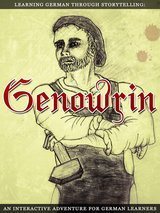
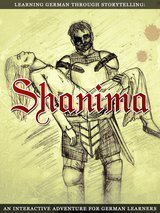

Visit the official website for the German fantasy adventure series
img: K-Power 5, 1984, p.24, via ? Daniel Rehn (CC)

 About the author:
André Klein was born in Germany, has grown up and lived in many different places including Thailand, Sweden and Israel. He has produced two music albums, performed and organized literary readings, curated an experimental television program and is the author of various short stories and non-fiction works.
About the author:
André Klein was born in Germany, has grown up and lived in many different places including Thailand, Sweden and Israel. He has produced two music albums, performed and organized literary readings, curated an experimental television program and is the author of various short stories and non-fiction works.
The post German Gamebooks For German Learners appeared first on Learn Out Live!.





December 4, 2013
How To Create Free Custom Shortlinks

Shortlinks have been with us for a number of years now. Whether it’s bit.ly, tinyurl, or another service, URL shortening has risen in popularity together with Twitter, where every character counts and the only good link is a short link.
But besides shortening, another reason for using short links is to beautify long and ugly URLs. Here are some examples of URLs that would doubtlessly benefit from some shortening and beautifying.
So, let’s say we have a URL that looks like this:
http://www.domainhorror.com/vud#59474...
By using a link shortener such as bit.ly we could tame the beast so that it looks like this:
And for sharing that link around the web, in instant messages, Twitter, etc. it’s fine. It doesn’t clog up your character space. It’s short and compact — but what if you want to use the URL offline or somewhere else where the link can not be clicked but has to be copied (or worse: typed manually) into the address bar of your browser?
Friends Don’t Let Friends Type In Garbled Shortlinks
It has happened to me a number of times over the past few months that I stumbled over these short (but still horrible links) offline: in greeting cards, paperback books, etc.
And I always asked myself: who would actually type in these cryptic strings? Since the URL doesn’t consist of a simple human-readable word, it takes some concentration to get the link right, checking and double checking yourself with each character.
By using these shortened (but cryptic) links you can guarantee that some people will never visit the link, simply because it’s too much of a hassle. (I’m aware that it’s not a lot of work per se to enter a string of 8 characters, but compared to just making one click, it certainly is.)
Luckily, bit.ly allows you to customize your shortlinks, free of charge, resulting in links that look like this:
Not only can you choose any human-readable text for you link, you even get statistics about how many people actually click/type in that URL. Let the inner data-junkie rejoice!
Most short-URLs are disposable, true. But if you create a short-link for future reference, I ask you to humanize it — no I implore you! Don’t let your friends, fans and customers face these vile aberrations. Even if you just want a quick link for your YouTube description (where links are clickable), make it easy on the eye and make your visitors happy.
Sure, all of that is no secret, but far too many people don’t seem to be aware of this. So now you can’t say you’ve never heard about it.
Okay … But How Does It Actually Work?
The process is very simple. Here’s how it goes:
1. Register at bit.ly
There’s the option of registering with Twitter or Facebook, so it only takes one click to create an account.
2. Paste your URL into the field next to the blowfish:
3. Then you will see a little popup window:

By clicking on the little pen icon, you can edit the link text (underlined above) to you heart’s content.

Aaah, that’s better. It wasn’t that difficult, was it?
-
photo: CC by sondergaard via flickr

 About the author:
André Klein was born in Germany, has grown up and lived in many different places including Thailand, Sweden and Israel. He has produced two music albums, performed and organized literary readings, curated an experimental television program and is the author of various short stories and non-fiction works.
About the author:
André Klein was born in Germany, has grown up and lived in many different places including Thailand, Sweden and Israel. He has produced two music albums, performed and organized literary readings, curated an experimental television program and is the author of various short stories and non-fiction works.
The post How To Create Free Custom Shortlinks appeared first on Learn Out Live!.





How To Create Custom Shortlinks For Free

Shortlinks have been with us for a number of years now. Whether it’s bit.ly, tinyurl, or another service, URL shortening has risen in popularity together with Twitter, where every character counts and the only good link is a short link.
But besides shortening, another reason for using short links is to beautify long and ugly URLs. Here are some examples of URLs that would doubtlessly benefit from some shortening and beautifying.
So, let’s say we have a URL that looks like this:
http://www.domainhorror.com/vud#59474...
By using a link shortener such as bit.ly we could tame the beast so that it looks like this:
And for sharing that link around the web, in instant messages, Twitter, etc. it’s fine. It doesn’t clog up your character space. It’s short and compact — but what if you want to use the URL offline or somewhere else where the link can not be clicked but has to be copied (or worse: typed manually) into the address bar of your browser?
Friends Don’t Let Friends Type In Garbled Shortlinks
It has happened to me a number of times over the past few months that I stumbled over these short (but still horrible links) offline: in greeting cards, paperback books, etc.
And I always asked myself: who would actually type in these cryptic strings? Since the URL doesn’t consist of a simple human-readable word, it takes some concentration to get the link right, checking and double checking yourself with each character.
By using these shortened (but cryptic) links you can guarantee that some people will never visit the link, simply because it’s too much of a hassle. (I’m aware that it’s not a lot of work per se to enter a string of 8 characters, but compared to just making one click, it certainly is.)
Luckily, bit.ly allows you to customize your shortlinks, free of charge, resulting in links that look like this:
Not only can you choose any human-readable text for you link, you even get statistics about how many people actually click/type in that URL. Let the inner data-junkie rejoice!
Most short-URLs are disposable, true. But if you create a short-link for future reference, I ask you to humanize it — no I implore you! Don’t let your friends, fans and customers face these vile aberrations. Even if you just want a quick link for your YouTube description (where links are clickable), make it easy on the eye and make your visitors happy.
Sure, all of that is no secret, but far too many people don’t seem to be aware of this. So now you can’t say you’ve never heard about it.
Okay … But How Does It Actually Work?
The process is very simple. Here’s how it goes:
1. Register at bit.ly
There’s the option of registering with Twitter or Facebook, so it only takes one click to create an account.
2. Paste your URL into the field next to the blowfish:
3. Then you will see a little popup window:

By clicking on the little pen icon, you can edit the link text (underlined above) to you heart’s content.

Aaah, that’s better. It wasn’t that difficult, was it?
-
photo: CC by sondergaard via flickr

 About the author:
André Klein was born in Germany, has grown up and lived in many different places including Thailand, Sweden and Israel. He has produced two music albums, performed and organized literary readings, curated an experimental television program and is the author of various short stories and non-fiction works.
About the author:
André Klein was born in Germany, has grown up and lived in many different places including Thailand, Sweden and Israel. He has produced two music albums, performed and organized literary readings, curated an experimental television program and is the author of various short stories and non-fiction works.
The post How To Create Custom Shortlinks For Free appeared first on Learn Out Live!.





November 28, 2013
Create Your Own Flashcards For Kindle

Flashcards are a time-tested tool of memorizing almost anything, from new vocabulary and technical terms to copious amounts of trivia facts. And nowadays we don’t even need to waste paper for creating them. There are many apps that allow you to create your own flashcards.
If you own the new Kindle Paperwhite, there’s even an integrated Flashcards feature which hooks directly into the dictionary look-up feautre. But even if you’re using an older Kindle, or one of the Kindle apps on your iPhone or iPad, you can still create your own flashcards, free of charge.
Why To Create Your Own Flashcards For Kindle
I am a quick study – I can memorize a script in an hour – but I can’t remember a name three seconds. I’ve even forgotten my wife’s name on occasion. - Don Adams
Maybe you’ve seen that there are many flashcards available for purchase through the Kindle Store, such as my colleague’s Hebrew flash cards, for example. And while some of these prepackaged flash card sets might be helpful for some language learners, there comes a point where one has memorized all the materials and needs more.
The easiest way to scratch that itch to simply create your own flash card resources. This way you can:
build a whole library of flash card sets on various topics
create flash cards for languages not officially supported by Kindle
add your own images to your flash cards
edit, organize and share your creations
That’s all fine and dandy, you might say, but how does one actually go about making one’s own Kindle flash cards? I’m glad you asked …
1. Find Or Create Your Own Flashcards set
Have you ever heard about Quizlet? Built in 2005 by 15-year-old (!) Andrew Sutherland for a high-school French class, the site has grown into one of the biggest online resources for self-paced learning. Quizlet does many things, but at its core are … you guessed it: flash cards.
It’s very simple to create your own flash card sets there and share them. Since Quizlet is a free and open community, there are also tons of flash cards already available. Within a couple of seconds you can find resources for literally any language from Arabic to Zulu.
For matters of illustration, let’s say we’re learning Sanskrit, a language which is certainly not supported by the Kindle Store, i.e. you won’t find any purchasable resources because the Kindle officially doesn’t display many non-Latin alphabets. However, most Kindle devices and apps are perfectly capable of displaying these alphabets when you create your own resources!
By using the Quizlet search, I found a flashcard set called: Fruits and Vegetables (in Sanskrit)
Since this resource features both an unsupported alphabet and images, I’ll use it as an example here. (And no, I can’t read Sanskrit, either.)
2. Export And Convert
After having found a flash card set or created your own, it’s time to export it. Look for the link that says “More Tools” and select “Export”
Next up …
… simply highlight and copy the URL of this page (marked above).
The next step is where the magic happens.
Go to kindle-convert.bixly.com and paste the URL into the field that says “Quizlet Export URL” (marked below).
Before you hit submit, give your Kindle flashcards set a Title and author name, and – important! – select how you want your flashcards to be organized. You can either have terms and definitions (e.g. vocabulary – translation) on one page or separately. For now, I chose the second option.
3. Upload the Flash Cards Set To Your Kindle
Once you click the submit button, the flash cards will be downloaded and packaged in a Kindle-compatible format, called MOBI. When the download is finished, simply transfer the file to your Kindle device or app via email or – my favorite – using the Send to Kindle app.
And that’s it! Once the file has arrived on your Kindle, you can open it. Here’s how the above flash cards set looks on a Kindle Keyboard.
#gallery-1{margin:auto;}#gallery-1 .gallery-item{float:left;margin-top:10px;text-align:center;width:33%;}#gallery-1 img{border:2px solid #cfcfcf;}#gallery-1 .gallery-caption{margin-left:0;}
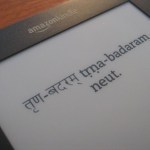
Sanskrit on Kindle Keyboard (K3)
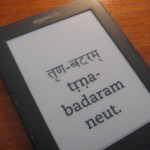
larger text on Kindle Keyboard (K3)

Sanskrit on Kindle iPad app
By moving from one page to the other you can “flip” the cards, as it were. Since these Kindle flash cards are “books” in a technical sense, you can’t randomize the order of the flashcards through your Kindle. If you want to re-order them, you’d have to do it in Quizlet, before exporting and converting.
-
photo: CC by wader

 About the author:
André Klein was born in Germany, has grown up and lived in many different places including Thailand, Sweden and Israel. He has produced two music albums, performed and organized literary readings, curated an experimental television program and is the author of various short stories and non-fiction works.
About the author:
André Klein was born in Germany, has grown up and lived in many different places including Thailand, Sweden and Israel. He has produced two music albums, performed and organized literary readings, curated an experimental television program and is the author of various short stories and non-fiction works.
The post Create Your Own Flashcards For Kindle appeared first on Learn Out Live!.





November 19, 2013
The Pleasure of Reading in a Foreign Language
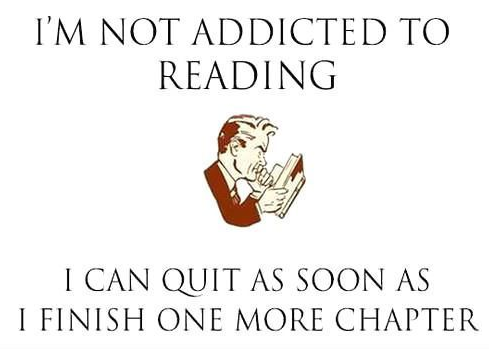
Apart from English fluency practice, the area most students want to concentrate on when they are with me on an intensive course is improving and expanding their English vocabulary. The activities we normally do together vary from collocations, idiomatic expressions, word formation, phrasal verbs, and identifying vocabulary in reading texts.
Most students diligently record this new vocabulary and try to reproduce it in class, and after a two-week intensive course are encouraged by how much they have learnt. However, you never stop acquiring new vocabulary, so the real challenge is what to do after you go back to your busy lives and the time to practise and consolidate what has been learnt becomes more and more difficult.
This is a question my students often ask me. My unequivocal answer is read, read and read some more in the English language or in whatever language you are learning.
Everyone agrees that the more we read the more our vocabulary will improve over time. Reading also helps students develop an awareness of how the language is used whether it is the tenses, fixed expressions or collocations. I’ve certainly found that the more I read in Italian and French the more the language embeds itself into my subconscious. The same applies to your mother tongue.
However, when you are an adult learning a foreign language it is really difficult to know what to read. Children’s books are hardly going to be of interest to you. Adult books would be far too difficult and would quickly put you off reading for good if you had to look up a word in a dictionary every five words. Also, there is nothing worse than reading a book in a foreign language that is so difficult to follow that you stop following the storyline.I think that if you do not enjoy the story you will not enjoy and appreciate the language and the whole exercise will become a burden. Life is too short for that.
So what is the answer?
I recommend to all my students to start their English Language Reading journey with the Oxford Bookworms Library Series (OxfordBookworms ELT, OUP Oxford) or Macmillan Readers (Macmillan Publishers). The levels range from Starter (False Beginner) to Stage 6 (Upper Intermediate). The series adapts published fiction and non-fiction for the English Language Learner. They offer the learner before and after reading activities and a glossary of new vocabulary at the end of the book.
The books are available in printed and e-book versions. For those of you who would like to practise your listening skills whilst listening to a great story, there are plenty of audiobooks to
choose from, too.
The books are short and can be completed in a reasonably short time. This, I think, is important as it gives the learner a sense of achievement when they have finished a book. It also encourages them to move on to the next level.
Give it a go and do let me know how you find them. More importantly, tell me if you enjoyed the experience. After all, reading in any language should be a pleasure, not a chore.
Ciao for now
Shanthi
-
credits: meme (unknown) and cat (unknown) via tumblr, shelves (Pierre BALLOUHEY)
You’ve been reading a guest post by Shanthi Cumaraswamy Streat

Shanthi Cumaraswamy Streat graduated in Politics and International Studies from the University of Southampton, UK in 1989. After 20 years in the world of Finance in such varied fields as life assurance, stockbroking, fund management, and wealth management, she decided to re-train as an English as a Foreign Language (EFL) Trainer. She studied for the CELTA at International House, London in 2009 and has since been a freelance English Language Trainer both offline and online.
She manages a blog: English with a Twist where she regularly blogs about the English Language and her experiences as an English Language Trainer.
You can follow her on:
Facebook Page: facebook.com/englishwithatwist
Twitter: @ ShanthiStreat
LinkedIn: linkedin.com/in/shanthicumaraswamystreat
Google +: plus.google.com/u/0/113677348491102566020/

 About the author:
Shanthi graduated in Politics and International Studies from the University of Southampton, UK in 1989. After 20 years in the world of Finance in such varied fields as life assurance, stockbroking, fund management, and wealth management, she decided to re-train as an English as a Foreign Language (EFL) Trainer. She studied for the CELTA at International House, London in 2009 and has since been a freelance English Language Trainer both offline and online.
About the author:
Shanthi graduated in Politics and International Studies from the University of Southampton, UK in 1989. After 20 years in the world of Finance in such varied fields as life assurance, stockbroking, fund management, and wealth management, she decided to re-train as an English as a Foreign Language (EFL) Trainer. She studied for the CELTA at International House, London in 2009 and has since been a freelance English Language Trainer both offline and online.
She manages a blog: English with a Twist/ where she regularly blogs about the English Language and her experiences as an English Language Trainer.
The post The Pleasure of Reading in a Foreign Language appeared first on Learn Out Live!.

































